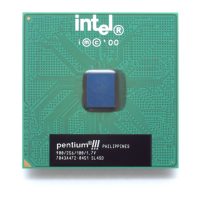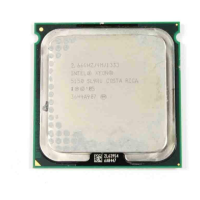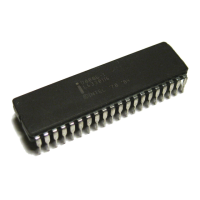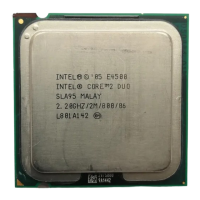82 Datasheet
Thermal Specifications and Design Considerations
5.2.4 PROCHOT# Signal
An external signal, PROCHOT# (processor hot), is asserted when the processor die temperature
has reached its maximum operating temperature. If the Thermal Monitor is enabled (note that the
Thermal Monitor must be enabled for the processor to be operating within specification), the TCC
will be active when PROCHOT# is asserted. The processor can be configured to generate an
interrupt upon the assertion or de-assertion of PROCHOT#. Refer to the Intel Architecture
Software Developer's Manuals for specific register and programming details.
The Pentium 4 processor in the 775-land package implements a bi-directional PROCHOT#
capability to allow system designs to protect various components from over-temperature situations.
The PROCHOT# signal is bi-directional in that it can either signal when the processor has reached
its maximum operating temperature or be driven from an external source to activate the TCC. The
ability to activate the TCC via PROCHOT# can provide a means for thermal protection of system
components.
One application is the thermal protection of voltage regulators (VR). System designers can create a
circuit to monitor the VR temperature and activate the TCC when the temperature limit of the VR
is reached. By asserting PROCHOT# (pulled-low) and activating the TCC, the VR can cool down
as a result of reduced processor power consumption. Bi-directional PROCHOT# can allow VR
thermal designs to target maximum sustained current instead of maximum current. Systems should
still provide proper cooling for the VR, and rely on bi-directional PROCHOT# only as a backup in
case of system cooling failure. The system thermal design should allow the power delivery
circuitry to operate within its temperature specification even while the processor is operating at its
Thermal Design Power. With a properly designed and characterized thermal solution, it is
anticipated that bi-directional PROCHOT# would only be asserted for very short periods of time
when running the most power intensive applications. An under-designed thermal solution that is
not able to prevent excessive assertion of PROCHOT# in the anticipated ambient environment may
cause a noticeable performance loss. Refer to the Voltage Regulator-Down (VRD) 10.1 Design
Guide for Desktop Socket 775 for details on implementing the bi-directional PROCHOT# feature.
5.2.5 THERMTRIP# Signal
Regardless of whether or not the Thermal Monitor feature is enabled, in the event of a catastrophic
cooling failure, the processor will automatically shut down when the silicon has reached an
elevated temperature (refer to the THERMTRIP# definition in Table 4-3). At this point, the FSB
signal THERMTRIP# will go active and stay active as described in Table 4-3. THERMTRIP#
activation is independent of processor activity and does not generate any bus cycles.
5.2.6 T
CONTROL
and Fan Speed Reduction
T
CONTROL
is a temperature specification based on a temperature reading from the thermal diode.
The value for T
CONTROL
will be calibrated in manufacturing and configured for each processor.
When T
diode
is above T
CONTROL
, then T
C
must be at or below T
C-MAX
as defined by the thermal
profile in Table 5-2
and Figure 5-1; otherwise, the processor temperature can be maintained at
T
CONTROL
(or lower) as measured by the thermal diode.
The purpose of this feature is to support acoustic optimization through fan speed control. Contact
your Intel representative for further details and documentation.

